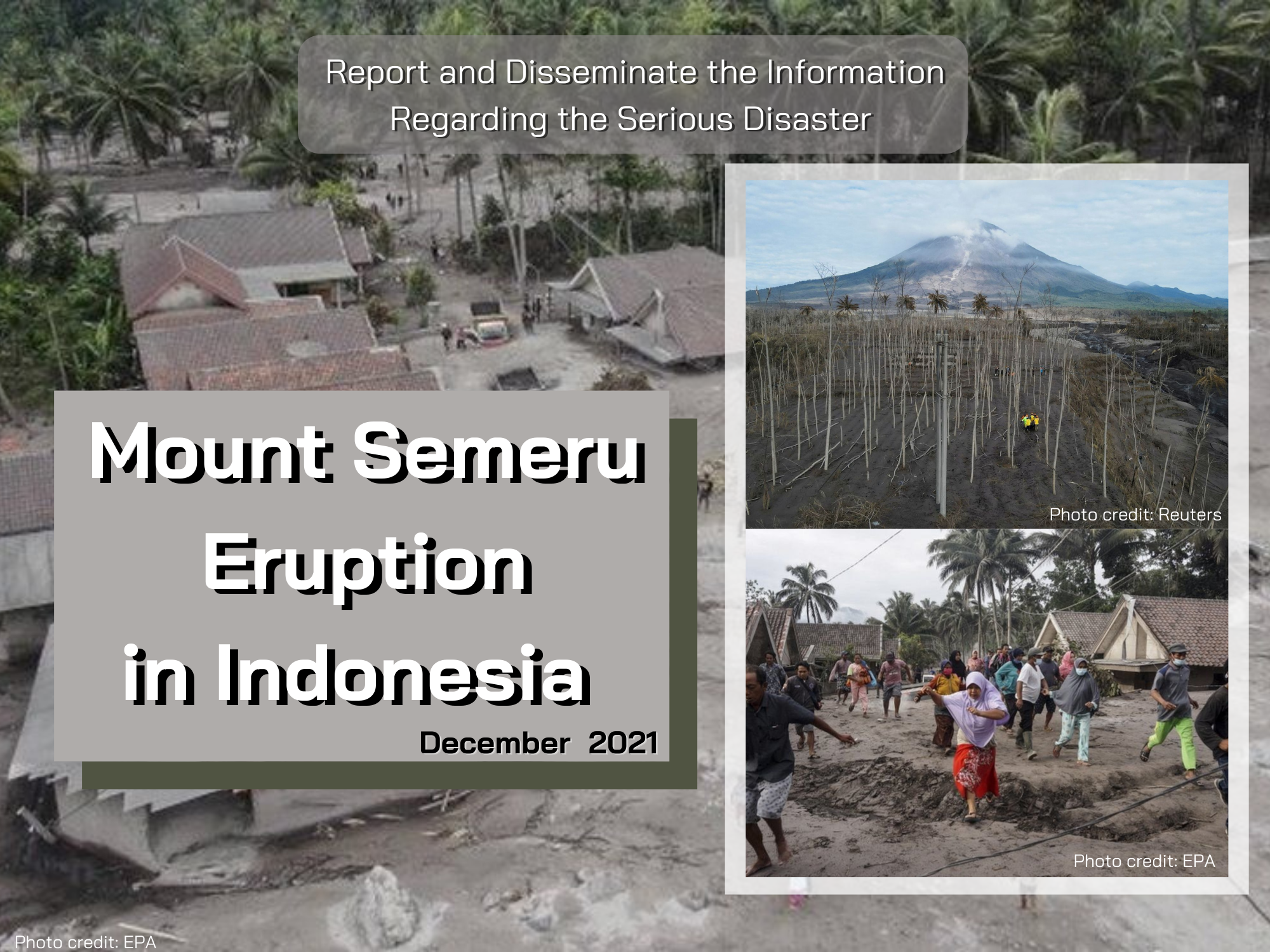
.png)
Report and Disseminate the Information Regarding
the Serious Disaster
Mount Semeru Eruption
December 2021
Source: ASEAN Disaster Monitoring & Response System (DMRS); Pacific Disaster Center (PDC Global); Indonesia’s National Agency for Disaster Countermeasure (BNPB); Indonesia’s Centre of Volcanology and Geological Hazard Mitigation (PVMBG); Center for Agricultural Data and Information System, Ministry of Agriculture, Republic of Indonesia
Mount Semeru Eruption in East Java Province, Indonesia.
Mount Semeru in East Java province erupted on December 4th, 2021. The affected areas are located in 2 districts in East Java province namely, Lumajang and Malang. The areas that were damaged are located in 2 sub-districts in Lumajang, while 1 sub-district in Malang (Jabung sub-district) was only exposed to volcanic ash with no other damages. Moreover, quite severe damages had occurred in Pronojiwo sub-district (villages: Supiturang, Oro-Oro Ombo, Sumberurip) and Candipuro sub-district (villages: Sumberwuluh and Sumbermujur).
These 2 sub-districts are in Lumajang district which is one of the rice-producers in East Java province, including the top 10 rice production centers of East Java.
The damage to paddy fields in these 2 sub-districts, especially in Candipuro sub-district which is the main rice center of the Lumajang district, will certainly have great effect on the rice production. When the disaster occurred, the average age of paddy plants was around 1-2 months. Therefore, the damage to paddy fields will disrupt the availability of rice forthe next 2-3 months. To anticipate the disruption effect to food availability, the government through the Ministry of Agriculture and the regional Agriculture Office will manage the distribution of rice from other areas to meet the needs of the population in Lumajang district. The similar action will be done for another food commodities such as maize, soybean, etc. After the condition of the land is conducive, the government will help farmers to plant food commodities. The assistance that has been prepared includes seeds and machine tools such as tractors and hand sprayers.
Production or plants in terms of the area or number that were affected by the eruption are as follows:
a. Food crops: rice 375 hectares, maize 46 hectares, cassava 23 hectares.
b. Horticulture: vegetables and fruits 241 hectares.
c. Estate crops 166 hectares (sugarcane, coffee, cloves, and coconut).
d. Livestock: 174 cows and goats.
The government of Indonesia hasthe countermeasures or policies to encounter this situation by carrying out emergency evacuation of the victims in cooperation with the local government, Indonesia’s National Agency for Disaster Countermeasure (BNPB), army, police, and volunteers to clean up the mudslides and distribution of logistics and basic needs such as food, clothes, and medicine for refugees. Ministry of Agriculture (Indonesia) has also given donation of rice, corn, coffee seeds, cattle, goats, animal feed, concentrates, animal medicines, tractors, and hand sprayers for farmers' groups to speed up the agricultural sector’s recovery. However, until now there has been no assistance or help from other countries either through government or other social institutions.
Indonesia has entered the rainy season with high intensity of rainfall since October 2021. Therefore, floods usually caused damage to food crops. Floods occurred in several areas in Indonesia, such as West Nusa Tenggara, West Kalimantan, Riau, and Banten, which have the potential to reduce the production of food crops.
Download word file click here --> Mount Semeru erupted in Indonesia

On Sunday, November 3, 2024, at 22:57 WITA, Mount Lewotobi Laki-Laki, one of Indonesia’s 120 active volcanoes, erupted on the island of Flores in East Nusa Tenggara province, The eruption, lasting 24 minutes (1,450 seconds), was recorded with a massive amplitude of 47.3 mm. According to Indonesia's National Disaster Management Agency, a strong eruption sent ash up to 2,000 meters (6,500 feet), affecting over 10,000 people. Smaller eruptions followed on November 5-6. In response, the Center for Volcanology and Geological Hazard Mitigation (PVMBG) raised the volcano’s alert status to “Awas” (Level IV), indicating a high danger level.

On November 12, 2024, Dr. Sumanya Nagdee, AFSIS Manager, participated in the Completion and Handover Ceremony for the project "Establishing Real-Time ASEAN Food Security Information System (AFSIS) and Development of Human Resources 3rd Phase – Pilot Project on Strategic Crop Forecasting System for Food Security in Indonesia." The event, which took place in Jakarta, Indonesia, was supported by the Government of the Republic of Korea and This meeting was chaired by Ms. Intan Rahayu, Director of the Center of Agricultural Data and System Information (CADIS) under Indonesia's Ministry of Agriculture, and Mr. An Jaerok, Vice President of EPIS from South Korea, along with representatives from various sectors.

According to the Mekong River Commission (MRC), heavy rain may cause flash floods and overflows, particularly in foothill and mountainous areas, affecting regions including Gia Lai and Kon Tum in Vietnam, as well as Bolikhamxay, Khammuane, Savannakhet, Salavane, Sekong, Champasak, and Attapeu in Laos, and Ratana Kiri and Stung Treng in Cambodia.

Severe Tropical Storm TRAMI (Local Name: Kristine) Causes Heavy Rainfall, Landslides and Widespread Flooding in the Philippines On October 22, 2024, Tropical Storm Kristine unleashed heavy rainfall, leading to severe flooding in multiple provinces. As of October 29, the National Disaster Risk Reduction and Management Council (NDRRMC) reported extensive damage to agricultural lands and infrastructure, prompting evacuations and relief efforts to assist affected communities. Local authorities are mobilizing resources to provide assistance and manage the unfolding disaster. As of October 30, the latest situation indicates that two cyclones struck the Philippines in quick succession, with Typhoon Leon entering the Philippine area of responsibility on October 26, just one day after Kristine departed.
Visitor Info 309465 | Today 216 | Yesterday 726 | This week 3495 | This Month 9448 | Total 309465
Copyright 2017. ASEAN Plus Three
Food Security Information System Rights Reserved.